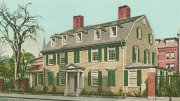1913
Mrs. George D. Widener lays the cornerstone of the Harry Elkins Widener Memorial Library during Commencement week.
1928
The Parietal Committee, facing new problems caused by an increasingly urban environment, forbids Harvard undergraduates to live in apartment houses.
1938
Members of the Harvard Young Communist League, promoting a peace strike on Boston Common, run afoul of the U.S. Post Office by stuffing House mailboxes with informational fliers. The postmaster plans to collect postage due, not the $300 per flier maximum fine.
1943
The Crimson ends publication for the duration; Harvard Service News adds undergraduate news to its coverage of the trainees stationed at Harvard.
1953
The Corporation decides not to remove three instructors who have refused to answer questions from congressional committees, but officially deplores the use of the Fifth Amendment by faculty members and states that “present membership in the Communist party,” in the absence of extraordinary circumstances, would be considered “grave misconduct, justifying removal.”
1963
Harvard, Radcliffe, and graduate-school students form the Harvard African and Afro-American Club.
1973
The Bulletin publishes “A Harvard Man’s Guide to the Watergate Scandal.” “Harvard men were not directly involved in the…break-in,” but all 13 alumni known to be otherwise linked to the proceedings are listed.
1988
President Bok announces plans for a University-wide institute to expand and accelerate AIDS research at Harvard.
1998
The Crimson celebrates its 125th anniversary, capping off a year that includes inauguration of free delivery to all undergraduates, a financial-aid program, and a change from a six- to a five-day-per-week production schedule.








